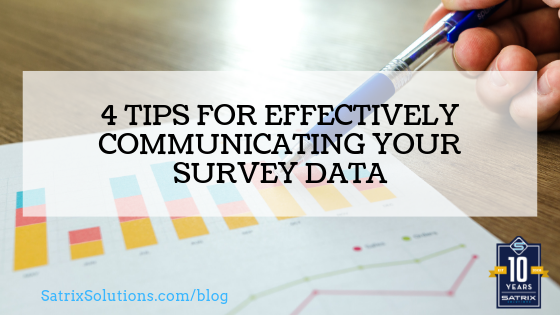My wife and I welcomed our firstborn son, Stanley, this past winter. Despite months of research, buying the latest gadgets, and a mountain of unsolicited parental advice, nothing prepared us for the loads of complicated information we would have to retain. Whether it’s navigating the complex world of insurance claims or heeding advice from the pediatrician, it can be a real struggle processing all this new information, particularly from experts in a field we have little familiarity with.
This experience made me think about the data we mine and analyze from the Net Promoter and Customer Satisfaction Survey programs we manage for our clients.
From the boardroom to the frontline staff, it’s critical for us to clearly convey the results and key takeaways in a thoughtful manner so the business leaders I work with can make informed decisions. With reaffirmed appreciation for this mission, here are my top guidelines for effectively communicating my data findings:
1. Keep your message simple.
This is more of a governing principal than a tip. Statistics, survey methodologies, text analytics, margin of error, etc., can be complicated for those not trained in the field, but your message shouldn’t be made hard to understand.
Let’s say you ran a multivariate regression model and found a couple of strong predictors of customer loyalty, a big takeaway you want to highlight. But to understand this finding, you probably don’t need to discuss the technical details of P-values and coefficients which can be difficult to explain to less data-savvy audiences.
Our job as data analysts is largely focused on mining for intelligence and processing information so business leaders can act. What we do can be difficult to explain, but our purpose is to help our stakeholders understand the relevant material. Of course, some audiences want to see our work and talk through the more analytical points, but I’d bet most members of your Board want to know the key takeaways more than the math behind them.
2. What is the minimum amount of context needed?
Identify the prerequisites necessary for understanding your message. Before you talk through the latest NPS results with your colleagues, it would be helpful to know their level of familiarity with the methodology and supporting research. If they aren’t, what educational materials should you include?
Context may not always require a lot of attention, but you run the risk of distracting or confusing your audience without it.
3. Cut the clutter.
This is especially true when delivering data heavy presentations. One of the first things I look for is repetitive information. Sometimes the slide title tells the audience everything they need to know, but so often the same language is repeated on the graph title or footer.
How about the actual data visuals? If you are speaking to the NPS trend going back 5 years, do you also need the standard deviation, margin of error, and/or the response rates on the same slide? It’s possible for the answer to be yes, especially when they influence how you view certain results, but if it’s not contributing to your point, consider removing it. Otherwise, it’s another opportunity to lose your audience’s attention.
4. Identify the evidence.
It may seem obvious, but as an objective third party “auditor,” I need to make certain my claims and recommendations are sufficiently supported, otherwise the integrity of my analysis may be questioned.
Back to your NPS survey. Say you identified a customer segment who is negatively impacted by a recent feature update, and you’re recommending a patch that will require resource allocation.
Consider the steps you took in your analysis to arrive at this conclusion. Was it the trending data? Did you single out a particular segment and compare it to the greater population? Or did you spend countless hours reading the open-ended commentary? These are items you probably need to share and speak to.
It may sound funny, but I pretend to be a lawyer going to court. I write out all the reasons for arriving at my conclusion and formulate my message as if I’ll be talking to a judge. As a bonus, I consider the conflicting opinions and formulate rebuttals. In rare cases, the rebuttal is stronger, and I’m forced to rethink my analysis but that’s just doing my job.
Communicating Your Survey Findings
One of the biggest duties I have as a survey data analyst is to make sense of seemingly complex subjects. I’ve seen talented mathematicians do incredible things with statistics, but struggle when communicating their findings.
Your CEO or Board of Directors are undoubtedly bright, but you may find yourself as the expert in the room and they’re trusting you to tell them what they need to know. Now if only my pediatrician could apply some of these tips!


